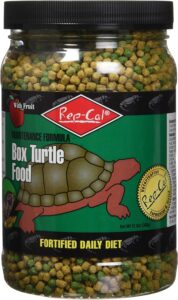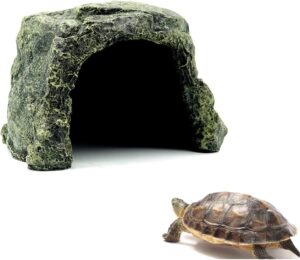How to care for a box turtle
Brief overview of box turtles as pets
How to care for a box turtle: Box turtles have long captured the fascination and adoration of reptile enthusiasts, making them a popular choice as pets. These fascinating creatures belong to the genus Terrapene and are known for their unique ability to retract their head, limbs, and tail entirely into their shell for protection. With their distinctive domed shells and vibrant patterns, box turtles make visually striking companions.
One of the remarkable aspects of box turtles is their longevity. When provided with proper care, these resilient reptiles can live for several decades or even reach a century in age.
This adds a sense of responsibility to prospective owners who must commit to providing lifelong care. Furthermore, engaging with these sentient beings can be an incredibly rewarding experience as they exhibit individual personalities and form deep bonds with their human caregivers.
Importance of proper care and habitat for box turtles
 While box turtles are captivating creatures, it is vital to comprehend the significant commitment required to maintain them as pets. Providing suitable care ensures not only the well-being but also the longevity of these endearing reptiles. One crucial aspect of responsible ownership is creating an appropriate habitat that closely mimics their natural environment.
While box turtles are captivating creatures, it is vital to comprehend the significant commitment required to maintain them as pets. Providing suitable care ensures not only the well-being but also the longevity of these endearing reptiles. One crucial aspect of responsible ownership is creating an appropriate habitat that closely mimics their natural environment.
Box turtles thrive in diverse habitats ranging from forests and grasslands to wetlands and meadows across North America. It is imperative to replicate this diversity within their enclosures by incorporating various natural elements such as rocks, logs, plants, and hiding spots.
By recreating a stimulating environment that mirrors their wild habitat, we enable them to exhibit natural behaviors like digging burrows or basking under sunlight. Adequate husbandry practices are essential in preventing potential health issues like shell deformities or respiratory infections that may arise from improper care conditions.
Maintaining optimal temperature gradients within the enclosure helps regulate body temperature while providing access to UVB lighting aids in vitamin D synthesis necessary for overall health. By ensuring a well-balanced diet and offering opportunities for exercise and mental stimulation, we not only contribute to the physical well-being of these fascinating creatures but also enhance their quality of life.
Understanding Box Turtles
Different Species of Box Turtles and Their Characteristics
Box turtles belong to the genus Terrapene and are known for their unique hinged shells that allow them to retract completely. Within this genus, there are several species, each with its own distinct characteristics.
One commonly kept species is the Eastern box turtle (Terrapene carolina), which is native to the eastern United States. It has a domed shell that ranges in color from brown to olive, with yellow or orange markings on its head and limbs.
Another popular species is the Three-toed box turtle (Terrapene carolina triunguis). As the name suggests, it has three toes on each hind limb instead of four like other box turtles.
This species also has a more flattened shell compared to its counterparts, making it well-adapted for digging into loose soil. The Ornate box turtle (Terrapene ornata) is another fascinating type often sought after by reptile enthusiasts.
It showcases intricate patterns on its shell, ranging from yellow and black to reddish-brown and black. This species also exhibits sexual dimorphism, with males typically having brighter colors and larger claws than females.
Lifespan and Size Variations Among Box Turtles
 Box turtles are known for their longevity compared to many other reptiles. When properly cared for, they can live well over 50 years in captivity.
Box turtles are known for their longevity compared to many other reptiles. When properly cared for, they can live well over 50 years in captivity.
However, lifespan can vary between different species and even individuals within a species. Eastern box turtles generally have a lifespan of 40-60 years in the wild but can live longer when kept in optimal conditions as pets.
Three-toed box turtles have similar lifespans as Eastern box turtles when cared for properly. In terms of size variations, adult Eastern box turtles typically reach lengths between 4.5 to 6 inches (11-15 cm) with males being slightly larger than females.
Three-toed box turtles are usually smaller, averaging around 4-5 inches (10-12 cm) in length. It’s important to note that proper nutrition and habitat conditions play a crucial role in their growth and overall size.
Understanding the various species and their characteristics, as well as the potential lifespan and size variations, is essential for providing adequate care for box turtles. By tailoring their environment and diet to meet the specific needs of each species, we can ensure a healthy and fulfilling life for these captivating reptiles.
Creating the Perfect Habitat
Indoor vs Outdoor Enclosures: Pros and Cons
Finding the right habitat for your box turtle is crucial to ensure their overall well-being. When considering whether to house your turtle indoors or outdoors, there are a few factors to take into account. Indoor enclosures provide you with greater control over the environment and protection from predators, while outdoor enclosures mimic their natural habitat more closely.
Indoor enclosures offer the advantage of being able to maintain a stable temperature throughout the year, which is especially important if you live in an area with extreme weather conditions. You can use heating lamps or heating pads to create a suitable temperature gradient within the enclosure for your turtle’s thermoregulation needs.
However, it’s important to ensure that there is proper ventilation and adequate space within the enclosure to prevent respiratory issues. On the other hand, outdoor enclosures allow box turtles to experience natural sunlight and fresh air, which are essential for their overall health.
Designing an outdoor enclosure with natural elements such as plants, rocks, logs, and even a small pond provides enrichment opportunities for your turtle while promoting physical activity and mental stimulation. However, it’s crucial to consider predator protection by using secure fencing around the perimeter of the enclosure and providing hiding spots.
Designing an Outdoor Enclosure with Natural Elements (e.g., plants, rocks, logs)
Creating an outdoor enclosure that resembles a slice of nature will provide immense benefits for your box turtle’s physical and mental wellbeing. The inclusion of various natural elements will encourage exploration behaviors while offering opportunities for basking and hiding. When designing such an enclosure, keep in mind these essential components:
Plants: Incorporate both live plants and artificial foliage in your outdoor enclosure. Native plant species are ideal as they provide shade as well as food sources if they produce fruits or edible leaves that align with your turtle’s diet.
Choose non-toxic plants such as hibiscus, dandelion greens, and hostas. Adding potted plants or creating a small greenhouse area can also offer protection during colder months.
Rocks and Logs: Introduce rocks of different sizes and textures to create natural basking spots for your box turtle. These rocks should be securely placed to prevent potential injury from toppling over.
Additionally, providing logs or fallen branches will give your turtle hiding places and opportunities for climbing, mimicking their natural environment. Water Feature: Consider adding a small pond or shallow water dish to the enclosure.
Box turtles will appreciate having access to water for drinking and soaking, which aids in hydration, shedding, and maintaining overall health. Ensure that the depth of the water is suitable for your turtle’s size; it should be shallow enough to prevent drowning but deep enough for them to immerse themselves.
Providing a Suitable Substrate for Burrowing and Nesting
Box turtles are known diggers, so it is vital to provide them with an appropriate substrate that allows them to exhibit their natural burrowing behaviors. A good substrate should be easy to dig through while also retaining moisture well.
Consider using a mixture of organic soil, sand, peat moss, and coconut fiber as a substrate in the outdoor enclosure. This combination provides a loose texture that facilitates burrowing while retaining moisture essential for nesting activities.
Ensure that the substrate is at least 6-8 inches deep throughout most of the enclosure but deeper in specific areas designated specifically for nesting purposes. Providing areas with different depths allows your turtle to choose its preferred spot based on temperature preferences.
Regularly monitor the moisture level of the substrate by checking its dampness at various depths. Mist the enclosure occasionally or use a sprinkler system if needed to maintain an optimal humidity level suitable for your particular species of box turtle.
By carefully considering indoor vs outdoor enclosures, incorporating natural elements, and providing a suitable substrate for burrowing and nesting, you will create a habitat that closely resembles your box turtle’s natural environment. This will contribute to their overall health, happiness, and longevity.
Temperature and Lighting Requirements
Maintaining Proper Temperature Gradient within the Enclosure (Cool vs Warm Zones)
Creating a suitable temperature gradient within the box turtle’s enclosure is of utmost importance to ensure their well-being and physiological processes. Box turtles are ectothermic creatures, meaning they rely on external sources of heat to regulate their body temperature.
To achieve this, it is crucial to establish distinct cool and warm zones within the habitat. In order to provide a comfortable environment for your box turtle, you must incorporate both a basking area where the temperature ranges from 85°F to 95°F (29°C to 35°C) and cooler areas with temperatures ranging from 70°F to 80°F (21°C to 27°C).
This temperature variation allows the turtle to move freely between different zones based on its thermoregulatory needs, enabling it to both warm up and cool down as required. To maintain these temperature gradients, you can use various heating methods such as heat lamps or ceramic heaters.
Place the primary heat source over the basking spot and position thermometers at different locations within the enclosure. Regularly monitor these temperatures and adjust accordingly by raising or lowering the wattage of bulbs or adjusting distances between heat sources and basking spots.
The Importance of UVB Lighting for Vitamin D Synthesis and Shell Health
One critical aspect often overlooked in box turtle care is providing adequate UVB lighting. UVB rays play a vital role in stimulating vitamin D synthesis in reptiles, which is crucial for proper calcium absorption necessary for bone health and shell development. Inadequate exposure to UVB radiation can lead to metabolic bone disease or shell deformities in box turtles.
To meet their UVB requirements, it is essential to invest in full-spectrum fluorescent bulbs specifically designed for reptiles. These bulbs emit both UVA and UVB rays necessary for the turtle’s overall well-being.
Position the UVB light source within the enclosure, ensuring that it is unobstructed by any plastic or glass barriers that may filter out these vital rays. The recommended daily exposure to UVB light should last between 10 to 12 hours, simulating a natural day-night cycle.
Remember to replace UVB bulbs every six months, as their output diminishes over time even if they continue to emit visible light. Additionally, it is advisable to install a timer to ensure consistent and proper lighting cycles.
Providing your box turtle with appropriate temperature gradients and access to adequate UVB lighting will not only contribute to its physical health but also enhance its overall quality of life. These environmental factors are essential in promoting natural behaviors and vitality in captive box turtles.
Feeding Box Turtles
Dietary preferences: omnivorous vs herbivorous species
Box turtles exhibit a range of dietary preferences, with some species being predominantly omnivorous while others lean towards herbivory. Understanding the specific dietary requirements of your box turtle species is crucial for providing optimal nutrition.
The Eastern box turtle (Terrapene carolina), for instance, is primarily omnivorous, meaning its diet should consist of both animal and plant matter. In contrast, the Desert box turtle (Terrapene ornata) tends to be more herbivorous, consuming mostly plant material.
Offering a balanced diet with variety (e.g., insects, fruits, vegetables)
How to care for a box turtle: To ensure a healthy and well-rounded diet for your box turtle, it’s essential to offer a diverse range of food items. For omnivorous species like the Eastern box turtle, this means incorporating both animal and plant matter into their meals. High-quality commercial turtle pellets can serve as a base diet that contains essential nutrients and vitamins.
In addition to pellets, supplement their diet with small prey items such as earthworms, crickets or mealworms to fulfill their protein requirements. Vegetables and fruits should also make up a significant portion of the diet for both herbivorous and omnivorous box turtles.
Dark leafy greens like kale or collard greens are packed with essential vitamins and minerals while providing valuable dietary fiber. Additionally, offering grated or sliced vegetables such as carrots or squash can add variety to their meals and contribute to increased nutrient intake.
Calcium supplementation to prevent shell deformities
One critical aspect of feeding box turtles that cannot be overlooked is calcium supplementation. Insufficient calcium in their diet can lead to debilitating conditions such as metabolic bone disease that affect the health and integrity of their shells. To prevent this, it is essential to provide a calcium source alongside their regular diet.
This can be achieved by dusting their food with a reptile-specific calcium powder, ensuring they receive adequate amounts of this vital mineral. It’s important to note that while calcium supplementation is crucial, excessive amounts can also lead to health issues, so moderation is key.
Understanding the dietary preferences of your box turtle species and providing a well-rounded and nutritionally-balanced diet is crucial for their overall health and well-being. Offering a variety of food items such as insects, fruits, vegetables, and high-quality commercial pellets ensures they receive the necessary nutrients.
Additionally, supplementing their diet with calcium helps prevent shell deformities and promotes optimal skeletal health. By catering to their specific dietary needs through an appropriate mix of animal and plant matter while incorporating essential supplements, you can ensure your box turtle thrives in captivity.
Hydration and Water Needs: How to care for a box turtle
Providing a Shallow Water Dish for Drinking and Soaking
One crucial aspect of caring for box turtles is ensuring they have access to clean, fresh water at all times. To meet their hydration needs, it is important to provide a shallow water dish within the enclosure.
The dish should be large enough for the turtle to comfortably fit in, but not too deep that it poses a drowning risk. A suitable water dish should have a gradual slope and allow easy entry and exit for the turtle.
In addition to drinking, box turtles also rely on soaking in water to maintain proper hydration levels and aid in shedding. Hence, the water dish should be deep enough to allow them to soak their entire body if they desire.
Soaking is particularly beneficial during molting periods when box turtles shed old skin or recover from shell injuries. By offering an appropriate-sized dish for both drinking and soaking purposes, you are ensuring your box turtle has access to vital moisture necessary for overall health and well-being.
Maintaining Clean Water to Avoid Bacterial Infections
How to care for a box turtle: Maintaining clean water within the turtle’s habitat is paramount as dirty or stagnant water can become a breeding ground for bacteria, leading to infections that can harm your pet’s health. Regularly changing the water in the turtle’s dish is essential; this should be done daily or at least every other day, depending on how quickly the water becomes soiled. When replenishing the dish with fresh water, it is crucial to use dechlorinated or filtered water since chlorine found in tap water can be harmful to turtles.
To minimize bacterial growth further, ensure that the shallow water dish is made of smooth materials that are easy to clean thoroughly between each use. Use mild soap and warm tap water while scrubbing away any debris or residue that may accumulate on the surface of the container.
Rinse the dish thoroughly, ensuring no soap residue is left behind. By maintaining a clean water source, you are reducing the risk of bacterial infections and promoting a healthier environment for your box turtle.
Creating a Separate Area for Soaking to Aid in Hydration
While providing a shallow water dish is important, it can also be beneficial to create a separate area specifically designed for soaking. This area should be larger than the water dish and have slightly deeper water to allow the turtle to fully submerge itself. A deeper soaking area enables better hydration as it allows more extensive contact between the turtle’s skin and water.
To create a suitable soaking area, you can use a plastic container or tray filled with clean, dechlorinated water. Ensure that the edges of the container are not too high or steep, allowing easy entry and exit for your box turtle.
Placing some rocks or pebbles within the soaking area can help provide grip for your pet while preventing accidental tipping over of the container. By offering both a shallow water dish and a separate soaking area, you are providing options for your box turtle to fulfill its hydration needs effectively.
Remember to monitor their behavior closely; if they spend an extended period in either spot or show signs of dehydration (e.g., sunken eyes or flaky skin), adjustments may need to be made to their habitat or diet. Remember that proper hydration is crucial for maintaining optimal health in box turtles, so paying attention to their water needs and providing suitable options ensures their well-being throughout their lives.

Exercise and Enrichment
Importance of regular exercise for overall health
How to care for a box turtle: Regular exercise is of paramount importance when it comes to ensuring the overall health and well-being of your beloved box turtle. Engaging in physical activities not only helps maintain a healthy weight but also promotes better cardiovascular function, stimulates digestion, and supports muscle development.
Box turtles are naturally active creatures, often found exploring their surroundings in the wild. Therefore, providing ample opportunities for exercise is crucial to mimic their natural behavior.
Providing opportunities for exploration through hiding spots, tunnels, or climbing structures
Creating an environment that encourages exploration is essential to keep your box turtle mentally stimulated and physically active. One way to achieve this is by incorporating various hiding spots, tunnels, or climbing structures within their habitat. These features will not only provide a sense of security but also allow the turtle to engage in natural behaviors such as burrowing or climbing.
You can use hollow logs, artificial caves, or even pottery pieces arranged strategically within the enclosure to create enticing spaces for exploration. Furthermore, constructing a network of tunnels using PVC pipes buried under the substrate will offer your box turtle an exciting labyrinth-like experience they would typically encounter in their natural habitat.
Tunnels should be wide enough for them to navigate comfortably while still providing a sense of enclosure. Including different levels and platforms where they can climb will further enhance their exercise routine while mimicking the challenges they would face in nature.
Stimulating the turtle’s mind with puzzle toys or food-dispensing devices
To keep your box turtle mentally engaged and prevent boredom-induced behaviors such as excessive pacing or aggression, consider introducing puzzle toys or food-dispensing devices into their habitat. These stimulating objects provide both mental and physical challenges as turtles work to access hidden treats or solve puzzles.
One option includes treat balls specifically designed for reptiles, which can be filled with their favorite insects or small pieces of fruits/vegetables. As the turtle rolls the ball around, they will need to maneuver it to retrieve the rewards, promoting both mental dexterity and physical coordination.
Additionally, puzzle toys that require problem-solving skills, such as ones with hidden compartments or sliders to unlock treats, can provide hours of entertainment. Remember that when introducing any new objects into your turtle’s habitat, ensure they are made from safe materials that are easy to clean and free from sharp edges or potential hazards.
Observe your turtle’s behavior closely during interactions with these enrichment items to ensure their safety and engagement. By prioritizing regular exercise through exploration opportunities and incorporating stimulating puzzle toys or food-dispensing devices into their routine, you will not only keep your box turtle physically fit but also mentally engaged and content in their environment.
Healthcare Considerations: How to care for a box turtle
Regular Veterinary Check-ups to Monitor Overall Health
 How to care for a box turtle: Proactive and regular veterinary check-ups are crucial for ensuring the well-being of your box turtle. By seeking professional advice, you can monitor your turtle’s overall health and identify any potential issues early on. A qualified reptile veterinarian will perform a thorough examination, checking for signs of illness, infections, or abnormalities.
How to care for a box turtle: Proactive and regular veterinary check-ups are crucial for ensuring the well-being of your box turtle. By seeking professional advice, you can monitor your turtle’s overall health and identify any potential issues early on. A qualified reptile veterinarian will perform a thorough examination, checking for signs of illness, infections, or abnormalities.
They will also provide guidance on proper diet, habitat conditions, and specific care requirements based on the species of your box turtle. During these check-ups, the vet may also conduct fecal examinations to screen for internal parasites.
This is important as untreated parasitic infections can severely impact a turtle’s health. Additionally, veterinarians can administer vaccines and perform necessary diagnostic tests such as blood work to assess organ function and detect any underlying health concerns.
Common Health Issues in Box Turtles (e.g., Respiratory Infections, Shell Rot)
Box turtles are not immune to health issues; hence it is essential to be aware of some common problems that may arise. Respiratory infections can occur if the enclosure lacks appropriate temperature gradients or if there is poor ventilation.
Symptoms include wheezing, nasal discharge, lethargy, and loss of appetite. Prompt veterinary attention is crucial to prevent further complications.
Shell rot is another problem that often affects box turtles kept in inadequate environments with poor hygiene practices or damp substrate. This condition manifests as softening or discoloration of the shell due to bacterial or fungal infections.
Regularly inspecting your turtle’s shell and providing clean habitat conditions can help prevent this issue. It’s worth noting that maintaining proper husbandry practices such as ensuring a suitable temperature gradient within the enclosure, providing a balanced diet with adequate calcium supplementation, and maintaining clean water sources are all key in preventing various health complications in box turtles.
To sum up how to care for a box turtle
Caring for a box turtle requires diligent attention to their overall health and well-being. Regular veterinary check-ups are essential for monitoring your turtle’s health status and catching any potential problems early on.
By providing proper husbandry practices, such as maintaining an appropriate temperature gradient, offering a balanced diet, and ensuring clean and suitable habitat conditions, you can prevent common health issues like respiratory infections and shell rot. Remember, with the right care, box turtles can lead long and thriving lives as beloved pets.
Embracing the responsibility of their care provides an opportunity to appreciate these incredible reptiles’ beauty and uniqueness. So, make it a priority to provide your box turtle with a loving home filled with proper care and attention to ensure their vitality and happiness for years to come.
Further Reading
How To Keep My Turtle Tank From Smelling
How To Decorate a Turtle Tank: DIY Guide


